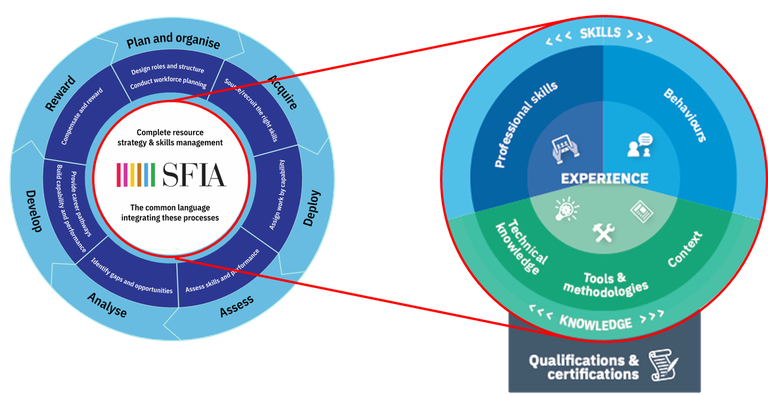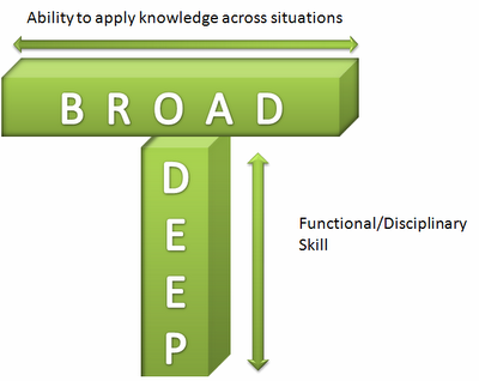T-shaped roles
Review of T-shaped roles and T-shaped people
Disclaimer:
These pages are part of the SFIA 8 project.
This is still work in progress.
The content may be changed and/or removed at any time.
They do not form part of the published SFIA framework.
Contents
-
Different approaches for describing the concept of T-shaped
-
SFIA positioning
-
How SFIA 7 already supports T-shaped roles
-
Opportunities for SFIA 8 and/or the wider SFIA ecosystem
-
Further experimenting. T-shaped roles - SFIA and Bloom's taxonomy
Your comments...
- You can add comments in the box at the bottom of the page - you will need to be logged in.
- Alternatively send your feedback to the SFIA Updates Manager.
Different approaches for describing the concept of T-shaped
- There’s lots of different shapes and letters used to describe the concept.
- We have captured a few in the slide share below
- I-shaped, T-shaped, Dash-shaped, Pi-shaped, Comb-shaped, A-shaped, V-shaped
- Specialist, Generalist, Versatilist
- Looking at all of these models it is clear that
- the different models do not describe the mechanics/detail consistently - in fact it would be a miracle if they did
- generally the difference between knowledge, skills, competencies is all mixed up and sometimes used interchangeably
- even where the same model is used (T-shaped being the most popular) it is used to describe different concepts
SFIA positioning
There is no industry standard definition of T-shaped
- This should not be a surprise. Its just like job titles, role profiles, organisation structures. The industry is fast moving in picking (and throwing away) concepts and ideas to help themselves.
- So SFIA cannot/does not need to map to an "industry standard"
- The flipside is also true. Organisations also need to think hard about what they need from a T-shaped role. There is no proven or consistent model to be picked up off the shelf.
Our key message is both familiar and consistent “SFIA is flexible by design”
- You can map any approaches to role design, working patterns, career development using the existing components of the SFIA framework – see graphic
To incorporate SFIA skills and levels of responsibility into the T-shaped model
- The vertical of the T should list the things you have to be able to do
- This can be described by SFIA skills & levels/levels of Responsibility
- The horizontal of the T should be the things you need to know
- Increased / in-depth knowledge required for those things in the vertical
- On the outer edges of the horizontal line - being aware of concepts, processes, tools and how they fit your role is sufficient
How SFIA 7 already supports T-shaped roles

SFIA has been helping organisation's resolve issues and design solutions for a long time. Here's some ways that SFIA can help with the concept of T-shaped people.
- Diagnosis
- what problem am I trying to resolve if a T-shaped role is the answer
- difference between skills/competencies, behaviours and knowledge
- Planning and organising
- organisation design – do we want T-shaped people, T-shaped roles, multi-skilled teams
- filling skill gaps e.g. development paths to fill cyber security gaps
- Design T-shaped roles
- bring clarity to what the person in the role needs to know and what they need to do - (SFIA skills and levels)
- Recruit/Acquire and Assessing
- identifying T-shaped people,
- Deploying
- Targeted deployment also provides the best opportunity for individuals to develop new skills and knowledge
- Project and operational risks are reduced by assigning the right skilled people. Using SFIA means this is based on their actual capability, not just their technical knowledge.
- Developing
- Difference between developing new knowledge and being able to enact new skills and responsibilities for a T-shaped role
- Career paths encouraging people to be T-shaped
- Accreditation/Recognition
- accreditation for the different SFIA elements – knowledge and SFIA levels – to recognise T-shaped people
Opportunities for SFIA 8 and/or the wider SFIA ecosystem
Here are some areas to be explored...
-
Guidance on linking/mapping to sources of knowledge…
- SFIA does not describe knowledge.
- BUT – SFIA’s design explicitly recognises knowledge and has started to help organisations link knowledge to skills and competency levels.
- ACTION for SFIA 8 - create/refine guidance
-
Create prototype T-shape role profiles with SFIA skills and knowledge mapped…
- ACTION for SFIA 8 - Choose a DevOps role and a Service Management role
-
Developing a proficiency scale for knowledge…
- while SFIA has a proven scale (the 1 to 7) for skill/competency level the framework has never described a scale for knowledge.
- This is a step away from SFIA's current scope so needs to be considered before taking this direction
- There is benefit in SFIA recommending a scale for knowledge as it would visibly highlight how a knoeledge scale it is different than a scale for competency / responsibilities
- Other organisations have published knowledge scales but these rarely fit with SFIA's design principles
- ACTION for SFIA 8 – research / identify different approaches to a scale for knowledge. Publish and explain a scale which can work alongside SFIA to support T-shaped roles (and all other letters of the alphabet)
Further experimenting
- The following graphics explore some opportunities to describe and exploit SFIA and knowledge.
- These are experimental and are shared to encourage constructive feedback and comment.
T-shaped roles and Bloom's Taxonomy.
What happens if we try to combine the T-shape role with Bloom's taxonomy.


Can we align the highest levels of knowledge required with the core competencies/responsibilities of a role

Some worked examples
-
For a given role the model is not static - over time thing on the periphery of your knowledge may become more important
-
Topics that only needed knowledge may increase in importance and become a skill required for the role
-
This is a natural result of changes in the external environment (impact of social media channels on a service desk), changes in your responsibilities, organisation structures etc.
-
A model like this can be used to define the learning needs for roles and for individuals.
-
In this way the learning needed to develop competencies, skills can be distinguished from learning for knowledge and awareness.
Click for larger image
Click for larger image
 Click for larger image
Click for larger image

